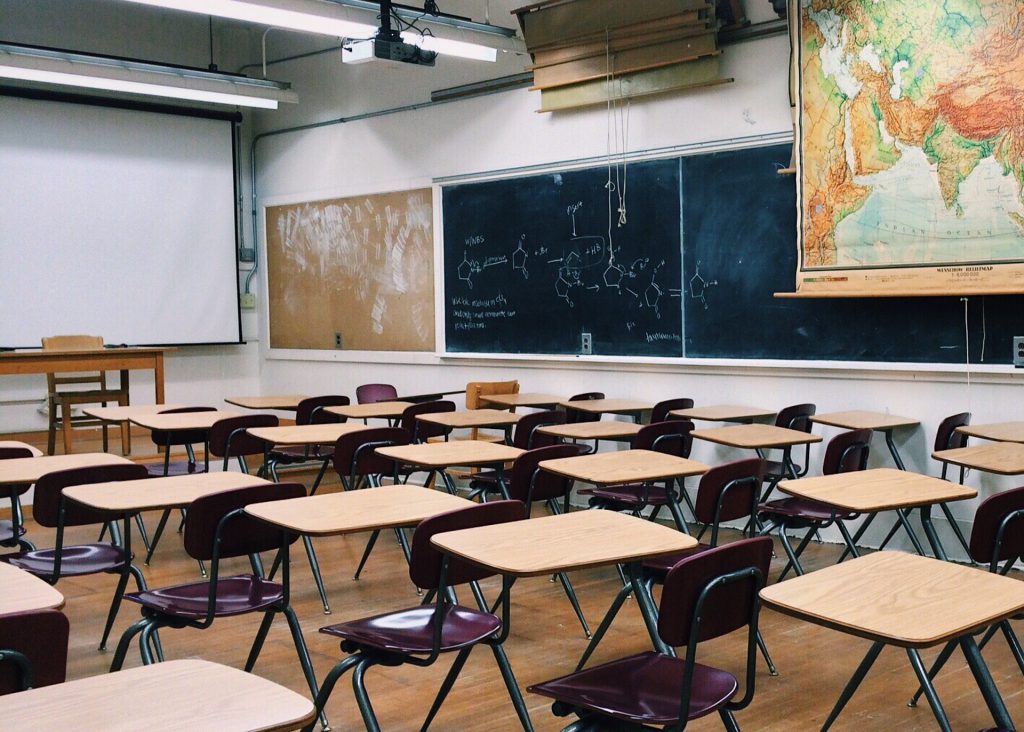Schools Scramble For Substitute Teachers
In Milwaukee, Kenosha, Superior. Some districts raising pay, offering bonuses.

School classroom. Image by Wokandapix on Pixabay
With COVID-19 cases once again surging in Wisconsin, schools are scrambling to find enough substitute teachers to cover for teachers who are out quarantining or sick.
Keeping enough substitutes in the roster was a challenge for schools even before the pandemic. Short-term substituting gigs are flexible. They’re able to pick which schools and classes they’ll cover, and whether to work when asked. But the job also usually lacks the benefits of a full-time job in teaching or elsewhere.
The return to classrooms during a pandemic has spiked the demand for substitutes, while also making some longtime subs rethink the job.
“Our ability to fill those positions has gradually just decreased — I think we have more people out that we used to have,” said School District of Superior superintendent Amy Starzecki. “The last two weeks have been our worst weeks in two years.”
Starzecki said Superior’s coverage rate — the share of absences they can cover with substitutes — is at 75 percent this year, down from 80 percent in 2018-2019 and 78 percent last year. The school district has covered those classes in a variety of ways: Starzecki and other administrators and school board members have jumped into the classroom, while clerical staff have covered lunch and recess periods when paraprofessionals and other staff are out.
“Our staff don’t hesitate to jump in and help each other,” she said. “I think it does contribute to burnout because many of our teachers end up missing their prep time — that’s time that they need to get ready for class.”
Starzecki said Superior had fewer substitutes at the start of the year than in previous years, though they’ve gotten 30 new substitute applicants since rolling out a robust campaign to attract new subs.
The number of applicants for substitute teaching licenses has been on the rise. From July 2020 to June 2021, nearly 4,000 people applied to be short-term substitutes, up from nearly 3,500 the year before and 3,200 in 2018-2019. Long-term subs took a dip in 2020-2021, with only 461 applicants compared to 540 in each of the prior two years, but overall, the applicant pool was bigger last year — but not big enough for schools to meet their growing need.
Karen Kempinen retired from her Kenosha teaching job when Act 10 passed in 2011, but subbed consistently until March 13, 2020 — the day schools across the state shut down. She’s continued to go through trainings on new technology to keep her skills up to date in case she does return, but said for now, the risks outweigh the benefits.
“It breaks my heart that people like me, who are qualified teachers, are not going in to sub, but most of us just can’t take the risk of getting sick,” she said. “I just didn’t feel like I would be able to offer my educational expertise, I didn’t feel that it was worth it for me to take the risk because I felt like I would just be monitoring students.”
Kempinen said she’s vaccinated, boosted and generally in good health, but her age group is at higher risk for severe cases of COVID-19. With Kenosha County just over 50 percent vaccinated, she said it doesn’t feel safe to spend time indoors around a lot of people.
As of Friday, there were nearly 10,000 people in Wisconsin with an active short-term substitute teaching license, and about 4,500 with an active long-term substitute license, according to the state Department of Public Instruction.
A long-term license requires completion of an approved educator preparation program and is good for five years, while a short-term license requires completion of an approved substitute training program and is good for three years.
When the pandemic began, some substitutes moved on to other, more stable jobs — or jobs offering higher wages and sign-on bonuses amid low unemployment rates.
“I didn’t really have to teach the class via Zoom or anything, I just had to post assignments over Google Classroom, and that was kind of disheartening in itself,” he said. “When summer hit, I was like, I’m not going to sub again, because I don’t know where this COVID stuff is going.”
Jackson now works at a nonprofit where he tutors and mentors MPS students and helps organize activities like swimming, golfing and other things around the city.
“Already, being a sub, it’s not very secure, you’re expendable … so I decided, I’m not gonna risk that, I’m gonna go ahead and find something else to do,” he said. “I still work with kids in person and everything — we’re showing them different places, different things that they haven’t been able to experience.”
To stay competitive, some schools have raised their rates and offered bonuses. Superior gives substitutes an extra $150 for every 20 days of substituting, as well as recruitment bonuses for Superior teachers who bring in new subs. Some schools also offer permanent substitute positions, where they’ll keep a substitute teacher on the payroll, with access to the same benefits and pay scale as other full-time employees and have them fill in wherever there are gaps. Some even have a pathway to becoming a fully licensed teacher in the district over the long term.
Corrie Dufresne has subbed around schools in Madison over the past three years, mostly picking up jobs at her own kids’ schools, and then was a full-time floater substitute at Randall Elementary School in the Madison Metropolitan School District in spring 2021. The consistency of being in the same school, and with the same staff, made things easier.
“If you’re at the same school every time, you know all the protocols,” she said. “It was definitely the easiest placement, because I was going in every day feeling comfortable about what I was doing, even though I was in different classrooms.”
She continued subbing into this school year, once again rotating through different schools as needed, but said it started feeling too risky — especially since her younger child wasn’t yet eligible to be vaccinated.
“It started feeling a little bit unsafe because all the classes I was going into were COVID classrooms — I was there because the teacher was out with either symptoms or a probable exposure,” she said.
Still, she said the need has only ramped up. All MMSD subs are put into an online system where they can see what jobs are available and pick up shifts. Previously, that was a pretty reliable way for schools to fill their openings.
“With COVID, a lot of the principals from the different MMSD schools are just sending emails to the subs now, I think in desperation,” she said.
MMSD put out a call to parents earlier this month asking for volunteers to substitute. Dufresne said she’d recommend the experience, and isn’t opposed to going back, especially now that her daughter is vaccinated and Dufresne has her booster shot, but she has too many other things on her plate at the moment to get back subbing.
Jackson, the former Milwaukee substitute, said he thinks schools might have more luck attracting and retaining substitutes if they put more effort into familiarizing subs with the schools and offering them support like ensuring teachers leave detailed lesson plans and offering benefits.
“Subs are needed, but it doesn’t make sense that we’re kinda just left in the dark,” he said. “I was blind, I had to learn day-by-day how to manage classrooms better, how to improvise if there was no real lesson plan for the day, things like that – you’re never bored, but it gets kind of scary.”
That perceived lack of support has been at the heart of Starzecki’s campaign to recruit more substitutes in Superior. If they’ve never subbed before, a new hire gets to spend their first day shadowing. Each substitute is assigned a mentor from the teaching staff who they can go to with questions, and principals and other staff at their grade level check in throughout the day.
“We know that substitutes will come back if we create really welcoming environments,” she said. “We don’t want our substitutes to have to be like, ‘Gosh, I wish I knew how to do this.'”
As Wisconsin weathers yet another COVID-19 surge, schools are scrambling for substitute teachers was originally published by Wisconsin Public Radio.




















I subbed for several years after my retirement in 2010. The shortage of subs became noticeably worse after Act 10 went into effect and the normal stream of grads from UW could be counted on to do subbing while awaiting a position. That stream dried up very quickly after Act 10 with students switching to other majors and made worse with teachers jumping from district to district to get a pay hike.
While finding subs is a problem right now, the real challenge that school districts will be facing is finding newly graduated certified teachers to replace those retiring or leaving the profession. Teaching has become politicized by the Republicans. Every day new teacher candidates can read about politicians proposing that teachers could be sued or fined for talking about race or faced threats or harassment from parents over some of the same issues. These conditions will drive many of these teachers to the private sector for better pay, respect, and no harassment and threats.